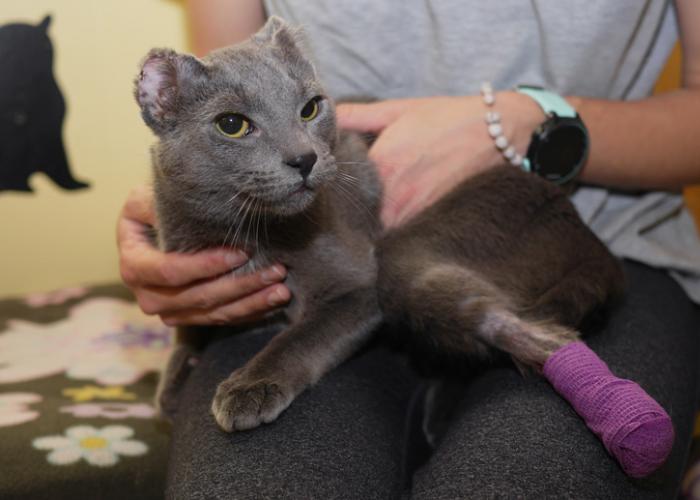What's that bug in your ear, kitty?
Recognizing and treating ear mites in cats

Click here for a downloadable, printable reference on diagnosing and treating ear mites.
If you’re around a lot of cats, you’ve probably seen it: Suddenly, one of them stops what she’s doing and begins violently scratching one of her ears with a hind foot, then shakes her head so hard that her ears flap, and then begins to scratch again. This time maybe it’s her other ear that she scratches, or maybe she rubs it with a front foot instead. After a while, she stops and looks up at you while holding her ears in an odd position—sideways and slightly down instead of up and forward like normal.
You guessed it—she has ear mites. And if one cat has them, the rest of the kitties around her will soon have them, too.
What Are Ear Mites?
Ear mites (Otodectes cynotis) are tiny parasites that live in the external ear canals—they can just barely be seen with the naked eye, resembling tiny white dots that slowly move. The most common cause of ear infections (otitis externa) in cats, they can cause intense itching. Ear mites are most common in young cats and kittens, but adults can also be infected. Because they are highly contagious, they are very common in multicat environments, especially those in which cats do not receive regular veterinary care.
Ear mites typically live and reproduce in the external ear canal, although they occasionally migrate to the head, face and neck. They feed on epidermal (skin) debris, causing irritation and inflammation. Infection is easily perpetuated as female mites produce microscopic eggs that hatch into larva and eventually develop into adult mites.
Over time, most cats with ear mites develop a characteristic dry black ear discharge that resembles coffee grounds. Infestation can be confirmed by examining the discharge under a microscope to positively identify the presence of ear mites.
Many cats with ear mites create small wounds on the backs of one or both ears, near the base. These are caused by the cats’ own claws during bouts of scratching. The wounds, which may be raw or covered with scabs, serve as telltale signs of infection. Another complication of severe scratching and shaking of the ears is a condition called a hematoma, where the earflap fills with blood. The violent scratching and shaking of the ears results in a blood vessel bursting within the flap, causing it to blow up like a water balloon. Hematomas can be surgically drained and corrected, or left to resolve slowly over time. Surgery will minimize the scarring and deformity, but the earflap will always remain somewhat thickened and irregular—often called a cauliflower ear.In some cases, cats with ear mites develop secondary ear infections with bacteria or yeast, which will require further treatment. Occasionally, itchy ears have other causes—such as an underlying allergy, foreign body, ear polyp or other mass. Cats will need to be evaluated so that proper treatment can be carried out. (Ear mites are far less common in dogs. The vast majority of dogs with ear infections have allergies with secondary bacterial and yeast infections, which must be diagnosed and treated accordingly. Fortunately, ear mites do not tend to infect people, although on rare occasions, mild skin rashes have been reported.)
With a little help from a veterinarian, shelter staff and volunteers can learn to recognize ear mites and develop protocols for treating infected cats. Treatment involves ear cleaning; killing the mites, including those that will continue to hatch from existing eggs; soothing irritated, itchy ears; and treatment of all animals in a group. The first three are discussed in detail below, but don’t forget the importance of treating the entire group—given the highly contagious nature of ear mites, this is crucial for successful elimination among cats in close contact with one another!

Ear Cleaning—Easy Does It!
Ear cleaning is important for a number of reasons. Accumulated debris can make it difficult for topical medications to penetrate and effectively kill the mites, and the ear discharge itself can predispose the cat to secondary bacterial and yeast infections. In some cases, the accumulated discharge may be so severe that it plugs the external ear canal, preventing the cat from hearing normally.But ear cleaning must be done with special care. Flushing or blind probing of the ears can cause serious problems, including rupture of the eardrums. In some instances, the cats’ eardrums will already be damaged as a result of infection, and vigorous cleaning makes things worse. If one or both eardrums are perforated or ruptured, infection can spread to the middle and inner ears. It is also possible for ear cleaners and medications to cause deafness if the eardrum is not intact. In fact, many commonly used products are “ototoxic,” meaning that if they flow past the eardrum into the middle ear, they will irreversibly damage the specialized nerve cells there.
But caregivers can learn techniques to gently and safely clean cats’ ears. First and foremost, never aggressively flush the ear with a bulb syringe, or blindly probe it with a Q-tip.
There are numerous commercially available ear cleaners for cats. Ceruminolytic cleaners are recommended for ear mite infestations because they are specially designed to dissolve thick, waxy discharge. I like Cerumene (Vetoquinol, USA), because it is highly effective and because studies demonstrate that it is nontoxic and will not cause deafness should it enter the middle ear. Mineral oil is also good at dissolving wax and is a cost-effective option for ear cleaning—but it should not be used in any case in which you suspect rupture of the eardrum (because of obvious signs of middle or inner ear infection, such as a head tilt or any time a cat’s ear appears to be very painful). In such instances, a veterinarian should have a look first before you proceed with any sort of ear cleaning or treatment.
Killing the Mites
There are a number of products available to treat ear mites. Some are applied topically directly to the ears or as a spot-on type treatment over the shoulders (i.e., a liquid applied to the skin all in one spot), while others are given orally or by injection. Some of these products are labeled for use in the treatment of ear mites, and some of them are recommended, but are considered “off-label” use. Many products must be prescribed or ordered by a veterinarian, but there are also several over-the-counter products available. With so many choices, consider what is most likely to be effective, as well as the time and cost involved.
Many over-the-counter topical ear-drop-type products contain insecticides that kill mites, but not their eggs. For this reason, repeated doses over three to four weeks are usually required to clear an infection—making them a labor-intensive option. In contrast, topical veterinary products (such as MilbeMite and Acarexx) call for only a single application, although many veterinarians follow up with a second treatment. Spot-on type treatments are popular and practical choices and can be applied monthly as part of a parasite control program, but tend to be relatively expensive. These include selamectin (sold as Revolution) and Imidacloprid/moxidectin (sold as Advantage Multi). Although not labeled for ear mites, topical fipronil (Frontline, PetArmor) has been reported to be effective as well.
Ear cleaning must be done with special care. Flushing or blind probing of the ears can cause serious problems, including rupture of the eardrums.
Many veterinarians use injectable 1-percent ivermectin solution to treat ear mites because it is highly effective and costs only pennies per dose. It can be given by mouth or injected under the skin. The drug is not FDA-approved for this use, though, and there are rare reports of toxic reactions in kittens. However, it has been widely used to treat ear mites for decades and is considered by many experts to be both highly effective and safe. Because it is a potent medication, it is imperative to use the proper dosage. A single dose is often effective, but for multicat infections or severe infections, repeated dosing at two-week intervals for three to four treatments may be necessary.
| Cat's Body Weight | Volume to Administer (mL) - SQ or PO once |
|---|---|
| < 5 lbs | 0.05 mL |
| 5-7 lbs | 0.1 mL |
| 8-10 lbs | 0.15 mL |
| 11-14 lbs | 0.2 mL |
| 15-20 lbs | 0.25 mL |
Soothing the Ears
Making sure the cats’ ears are comfortable is an important part of therapy. Many veterinarians will use a one-time application of a topical steroid after cleaning the ears to ease inflammation and itching. With most mite treatments, you’ll see notable improvement within a few days, and the prognosis is excellent. If discharge re-accumulates after cleaning and treatment, or if the ears become painful or have a foul smell, a veterinarian should examine the cat in order to determine the next steps.







